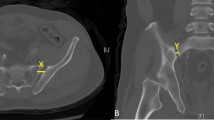Abstract
Secondary to the progress in interventional imaging, new therapeutic options have been developed that decrease potential complications because they are minimally invasive and they decrease patient rehabilitation time. As a diagnostic modality, computed axial tomography (CAT) allows precise evaluation of the degree of sacroiliac reduction that must be performed. Moreover, the use of CAT enables easy positioning of screws across the sacroiliac joint, thus avoiding nerve and vascular damage. We report our clinical experience of 20 patients treated by CAT-guided percutaneous fixation for posttraumatic unilateral sacroiliac disruption, including evaluation of our technique, its safety, and patient outcomes and long-term results. All patients in this study had successful outcomes, which were judged according to how much pain they experienced and how quickly they resumed normal activity after the procedure. Twelve of 16 patients were able to return to work by postoperative month 2. One patient had degenerative sacroiliac joint syndrome (5%), which was confirmed 6 months after surgery by CAT scan. None of the patients showed radiologic or clinical evidence of instability of the sacroiliac joint or screw migration. Postoperative follow-up, performed at 1, 2, and 3 years in our rehabilitation department, showed stable results over time. All pain disappeared, without the need for medication, in 19 patients (95%).







Similar content being viewed by others
References
Judet R, Judet J, Letournel E (1964) Fractures of the acetabulum: classification and surgical approaches for open reduction. J Bone Joint Surg Am 46:1615–1646
Nelson DW, Duwelius PJ (1991) CT-guided fixation of sacral fractures and sacroiliac joint disruptions. Radiology 180:527
Ebraheim NA, Rusin JJ, Coombs RJ, Jackson WR, Holiday B (1987) Percutaneous computed tomography-stabilization of pelvic fracture: preliminary report. J Orthop Trauma 1:197–204
Ziran BH, Smith WR, Towers J, Morgan SJ (2003) Iliosacral screw fixation of the posterior pelvic ring using local anaesthesia and computerised tomography. J Bone Joint Surg Br 85:411–418
Jacob AL, Messmer P, Stock KW, Suhm N, Baumann B, Regazzoni P, Steinbrich W (1997) Posterior pelvic ring fractures: closed reduction and percutaneous CT-guided sacroiliac screw fixation. Cardiovasc Intervent Radiol 20:285–294
Sciulli RL, Daffner RH, Altman DT, Altman GT, Sewecke JJ (2007) CT-guided iliosacral screw placement: technique and clinical experience. AJR Am J Roentgenol 188:W181–W192
Gay SB, Sistrom C, Wang GJ, Kahler DA, Boman T, McHugh N et al (1992) Percutaneous screw fixation of acetabular fractures with CT guidance: preliminary results of a new technique. AJR Am J Roentgenol 158:819–822
Tile M (1988) Pelvic ring fractures: should they be fixed? J Bone Joint Surg Br 70:1–12
Kellam JF, McMurtry RY, Paley D, Tile M (1987) The unstable pelvic fracture: operative treatment. Orthop Clin North Am 18:25–41
Bale RJ, Kovacs P, Dolati B, Hinterleithner C, Rosenberger RE (2008) Stereotactic CT-guided percutaneous stabilization of posterior pelvic ring fractures: a preclinical cadaver study. J Vasc Interv Radiol 19:1093–1098
Collinge C, Coons D, Tornetta P, Aschenbrenner J (2005) Standard multiplanar fluoroscopy versus a fluoroscopically based navigation system for the percutaneous insertion of iliosacral screws: a cadaver model. J Orthop Trauma 19:254–258
Tonetti J, Carrat L, Blendea S et al (2001) Clinical validation of computer assisted pelvic surgery using ultrasound. A percutaneous safe technique with low radiation exposure. Stud Health Technol Inform 81:515–520
Author information
Authors and Affiliations
Corresponding author
Rights and permissions
About this article
Cite this article
Amoretti, N., Hovorka, I., Marcy, PY. et al. Computed Axial Tomography-Guided Fixation of Sacroiliac Joint Disruption: Safety, Outcomes, and Results at 3-Year Follow-Up. Cardiovasc Intervent Radiol 32, 1227–1234 (2009). https://doi.org/10.1007/s00270-009-9618-3
Received:
Revised:
Accepted:
Published:
Issue Date:
DOI: https://doi.org/10.1007/s00270-009-9618-3




